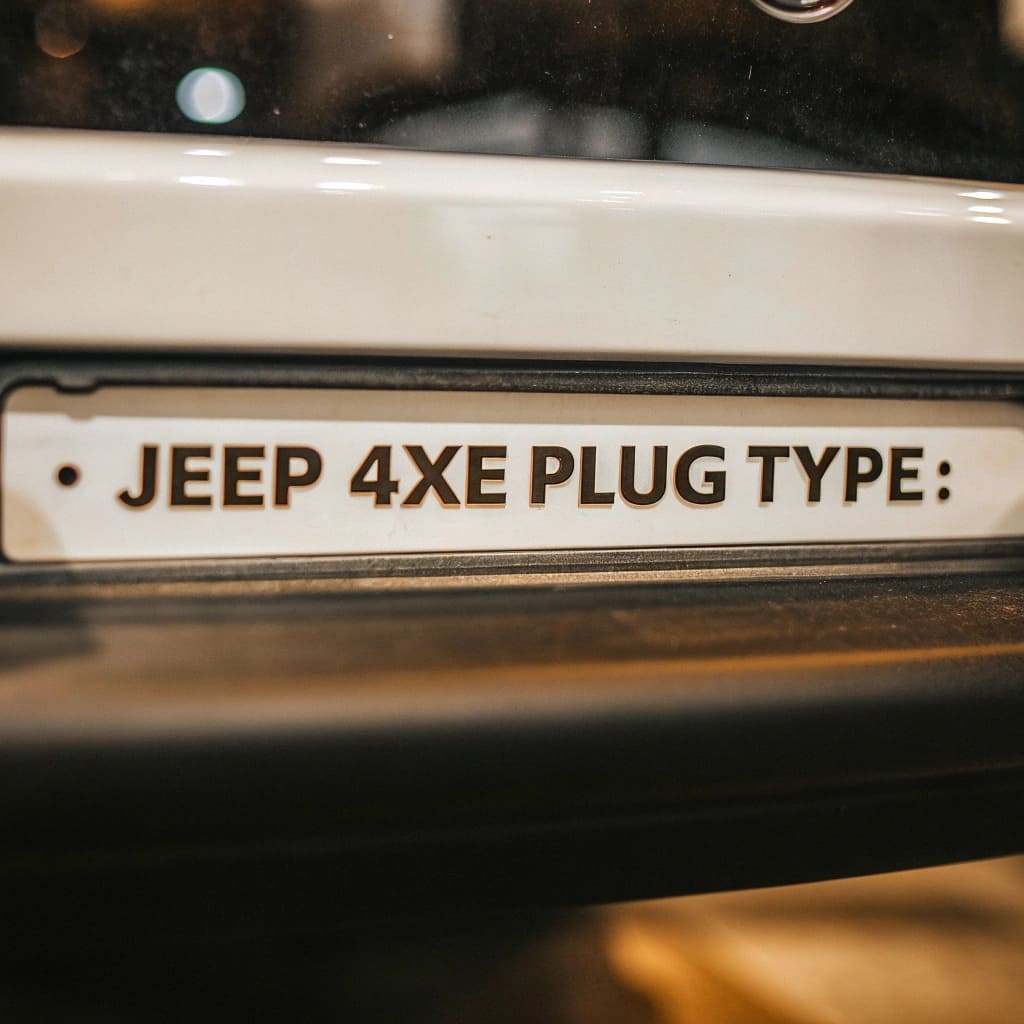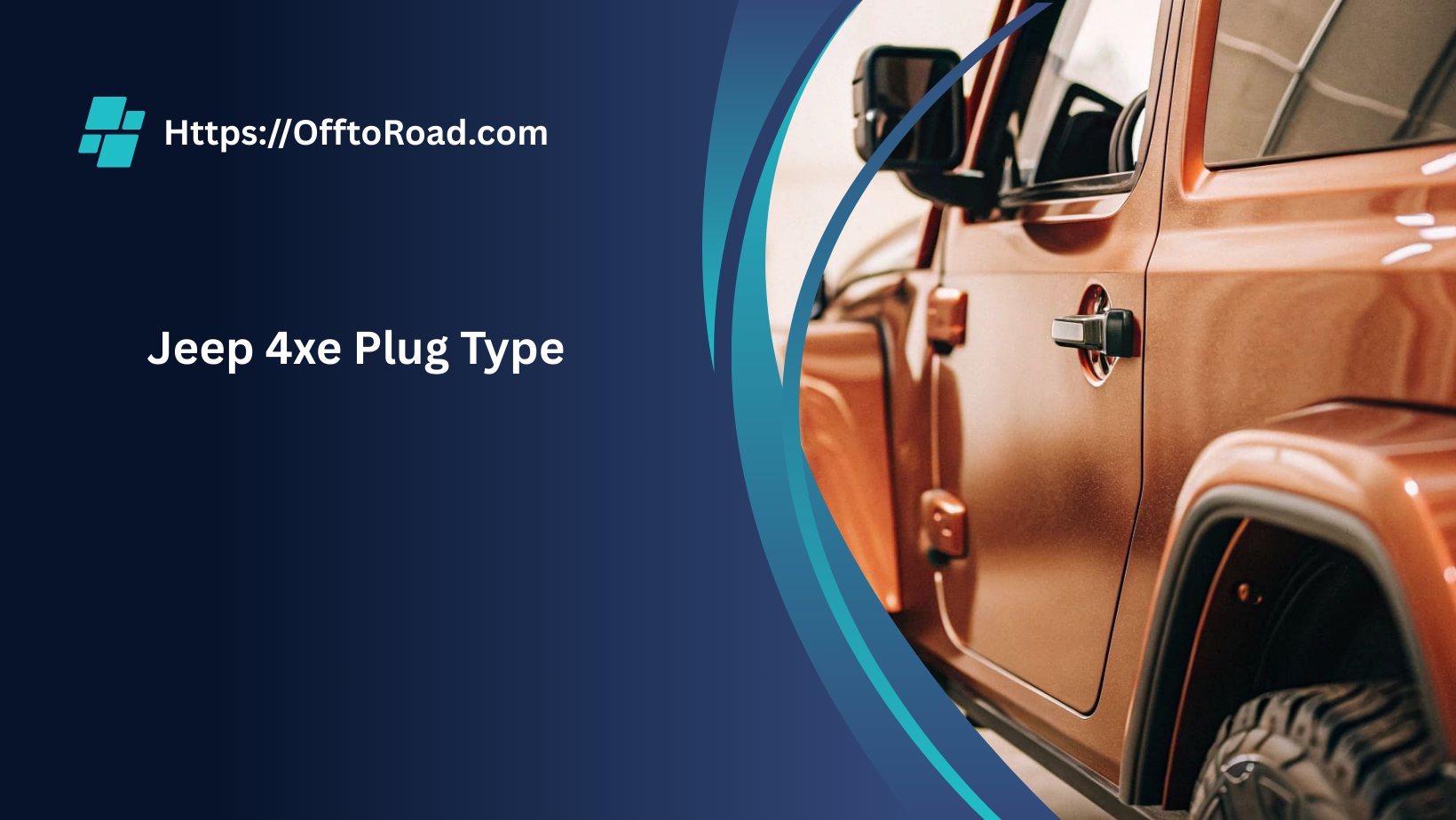So, you’re thinking about buying a Jeep Wrangler 4xe or maybe you already have one. Great choice! Now, one of the first questions you might have is:
“What kind of plug does the Jeep 4xe use?”
Don’t worry — you’re not alone. Let me break it down for you in the easiest way possible.
Learn all about the Jeep Wrangler 4xe plug type, charging options including Level 1 and Level 2, and where to find the charging port. Get answers to common questions about Jeep 4xe charging.
Quick Answer: Jeep 4xe Plug Type:
The Jeep Wrangler 4xe uses the J1772 plug (also called Type 1 in North America). This is the standard plug for most electric and plug-in hybrid vehicles in the U.S. It works for both:

- Level 1 Charging (that’s your regular 120V home outlet)
- Level 2 Charging (faster 240V charging, like at a public charger or special home charger)
| Feature | Details |
| Plug Type | J1772 (Type 1) |
| Charging Levels | Level 1 and Level 2 |
| Fast Charging | No DC fast charging support |
| Port Location | Front driver-side fender |
What Kind of Charging Does the Jeep 4xe Support?
Here’s the good news: your 4xe offers two simple and flexible ways to charge.
Level 1 Charging — Regular Home Outlet (120V):
You can just plug it into the same outlet you use for your phone charger or microwave. Easy, right? It takes about 12 to 14 hours to fully charge, so it’s perfect to leave it plugged in overnight while you sleep. Plus, Jeep includes this charger with the vehicle — no extra cost!
Level 2 Charging — Faster Charging at Home or Public Stations (240V):
If you want to charge faster, Level 2 chargers are the way to go. They can juice up your battery in about 2 to 3 hours. You can have one installed at home by an electrician or use public charging stations. These also use the same J1772 plug, so you don’t have to worry about compatibility.
What About DC Fast Charging? Can I Use It?
Many people wonder, “Can I use DC fast charging with my Jeep 4xe?” The quick answer: no. But that’s actually not a big deal. Here’s why.
Since the 4xe is a plug-in hybrid, it has a smaller battery — around 17.3 kWh — giving you about 21 to 25 miles of electric driving range.
Because of this smaller battery, it doesn’t need super-fast charging like full electric vehicles. Level 1 or Level 2 charging usually works perfectly for daily use.
Also Read: https://offtoroad.com/what-year-did-jeep-wranglers-get-backup-cameras/
Where’s the Charging Port on the Jeep 4xe?
When I first got my 4xe, I kept looking around the back, thinking the plug would be near the gas tank. Nope! It’s actually on the driver’s side front fender, just in front of the door.
Jeep made it super easy to find and use. The charging port even has a cool blue LED light ring that shows you the charging status:
| LED Light | Meaning |
| Blinking Blue | Charging in progress |
| Solid Blue | Fully charged |
| Blinking Red | Something’s wrong — check it! |
Charging Options Recap:
- Level 1 Charging — Plug into a regular 120V outlet. Takes about 12-14 hours. Perfect for overnight.
- Level 2 Charging — Use a 240V charger at home or public station. Charges in 2-3 hours.
Is Not Having DC Fast Charging a Problem?
At first glance, it might seem like a drawback. But here’s the thing:
Most 4xe owners don’t miss fast charging because the electric range is short and easy to recharge. You can plug it in at night and wake up to a full battery — no hunting for fast chargers. And if your battery runs low, the gas engine kicks in, so you’re never stuck.
Final Thoughts:
The Jeep Wrangler 4xe uses the standard J1772 plug for both Level 1 and Level 2 charging. It doesn’t support DC fast charging, but that’s totally okay because Level 2 charging is fast enough for everyday use.
Plus, the gas engine has your back when the battery runs low.
It’s a flexible, simple setup that works great whether you’re charging at home or on the go.
But Wait—Isn’t That a Downside?
At first glance, it might seem like a drawback. But here’s the thing:

Most 4xe owners don’t even miss fast charging.
Why? Because the electric range is short and easy to recharge. You can plug it in at night and wake up with a full battery—no need to sit at a charging station or hunt down a fast charger.
And if you ever run out of battery? No worries—the gas engine kicks in and keeps you going, just like a regular car. That’s the beauty of a plug-in hybrid!
Final Thoughts:
So, to sum it up in a friendly way:
No, the Jeep 4xe doesn’t support DC fast charging—but that’s totally okay. It charges fast enough with Level 2, and the gas engine has your back when the battery runs low.
If you’re mostly using it for daily commutes, short errands, or even just weekend drives, the charging setup works surprisingly well. It’s flexible, simple, and doesn’t lock you into finding a fast charger every time you’re out and about.
Where’s the Charging Port on the Jeep 4xe?
Great question—especially if you’re new to plug-in hybrids!
The charging port on the Jeep Wrangler 4xe is located on the driver’s side front fender, just in front of the door, right below the A-pillar. If you’re standing next to the driver’s side and facing the front of the Jeep, you’ll spot it easily—it’s tucked in neatly behind a small, flip-open charging door.
Also Read: https://offtoroad.com/can-235-80r17-fit-jeep-renegade-trailhawk/
What Does It Look Like?
It’s not just a boring plug—Jeep actually gave it a bit of style. You’ll notice a blue LED ring
around the port. That’s not just for looks—it gives you a quick glance at your charging status:
| LED Light | What It Means |
| Blinking Blue | Charging in progress |
| Solid Blue | Fully charged |
| Blinking Red | Something’s wrong—check it out |
So if you’re ever unsure whether your Jeep is charging or not, just take a peek at the light.
A Little Tip from Experience:
When I first got my 4xe, I kept walking around to the back, thinking the plug would be near the fuel tank. Nope! It’s right up front on the left side. Once you get used to it, it’s super convenient—especially when you’re parking head-in at a public charger or pulling into your garage at home.
To sum it up:
The Jeep 4xe charging port is on the driver’s side, near the front, and it’s easy to reach whether you’re charging at home or on the go. Jeep made sure it’s both practical and user-friendly.
Let me know if you’d like this section added to a full article or want help turning it into a blog post!
SEO Keywords Used Naturally:
- Jeep 4xe plug type
- What plug does Jeep 4xe use
- Jeep Wrangler 4xe charging port
- Jeep 4xe charging options
- Does Jeep 4xe support DC fast charging
- Level 1 vs Level 2 charging Jeep 4xe
What Plug Type Does the Jeep 4xe Use?

To wrap it all up:
The Jeep Wrangler 4xe uses the standard J1772 plug (Type 1 in the U.S.) for both Level 1 and Level 2 charging.
It does not support DC fast charging, but the battery charges quickly with Level 2.
Whether you’re charging at home or at a public station, the 4xe makes it easy and flexible to keep your hybrid running efficiently.
When It’s Not in 4WD, Is a Jeep Wrangler Rear-Wheel Drive or Front-Wheel Drive?
That’s a great question, and I totally get why you’d want to know! So here’s the deal: when your Jeep Wrangler isn’t in 4WD mode, it actually runs in rear-wheel drive — not front-wheel drive.
Let me explain why that’s the case.
Why Rear-Wheel Drive?
Unlike many SUVs that use front-wheel drive by default, Jeep keeps things a bit more traditional and rugged. The Wrangler sends power to the rear wheels when you’re just driving around normally—think cruising on dry pavement or running errands.
This setup isn’t just for show; it actually helps with things like:
- Better towing and hauling
- A stronger, more durable feel on the road
- Handling off-road conditions when you do switch into 4WD
So, it’s a smart design choice that fits Jeep’s off-road and tough vehicle reputation perfectly.
Also Read: https://offtoroad.com/how-much-to-wrap-a-jeep-wrangler/
How Do You Know When You’re in Rear-Wheel Drive?
Most Wranglers have a simple selector for drive modes, and here’s a quick breakdown:
| Mode | What Happens |
| 2H (2-High) | Rear-wheel drive — your everyday drive mode |
| 4H (4-High) | Four-wheel drive — for slippery or rough roads |
| 4L (4-Low) | Four-wheel drive — for serious off-roading or tough terrain |
So when you’re in 2H, you’re automatically running in rear-wheel drive. It’s the “normal” driving setting you’ll probably use most of the time.
Wrapping It Up:
In simple terms:
Jeep Wranglers are rear-wheel drive when not in 4WD mode.
They don’t use front-wheel drive at all.
If you’re ever wondering which wheels are doing the work, just glance at your drive mode selector—it’s the easiest way to keep track.
Are Jeep Wranglers Front-Wheel Drive or Rear-Wheel Drive?
That’s a great question, and I totally get why you’re curious! If you’ve been wondering how a Jeep Wrangler sends power to its wheels, you’re in the right place.
So, to put it simply: Jeep Wranglers are mostly rear-wheel drive vehicles when you’re not using four-wheel drive. But let me explain why that is — and why it actually makes a lot of sense.
Rear-Wheel Drive Is the Default Setup:
First off, when you’re driving your Wrangler in its usual mode, which Jeep calls 2H or 2WD, the power goes to the rear wheels only. This might sound old-school, but there’s a good reason behind it.
Rear-wheel drive gives you better balance and handling, especially when you’re towing something or carrying heavy gear. Plus, it’s a more rugged setup, perfect for the kind of off-road adventures Jeep is famous for.
Jeep Wranglers Don’t Have Front-Wheel Drive — Here’s Why?
Now, you might be wondering: What about front-wheel drive? Well, Wranglers simply don’t come with that option. Unlike many everyday SUVs that use front-wheel drive for their base setup, Jeep sticks to rear-wheel drive because it’s stronger and more durable.

When you need extra grip — like on muddy trails, snowy roads, or rocky terrain — you just switch your Wrangler into 4WD mode, and power goes to all four wheels.
Why Does This Matters for You?
Understanding this really helps you know what to expect when you’re behind the wheel. Most of the time, your Jeep is cruising around in rear-wheel drive, giving you a smooth and reliable ride.
But whenever the road gets tough or slippery, flipping on 4WD gives you that extra boost of traction and confidence to handle whatever comes your way.
Do Wranglers come in 2WD?
Yes, Wrangler models do come with a 2WD mode—often called 2H—which means the power goes to the rear wheels only.
This setup is great for regular, everyday driving when the road is dry and clear. But when things get tricky, like mud or snow, you can easily switch over to 4WD for that extra grip and confidence.
FAQ’s
1. How Long Does It Take to Fully Charge the Jeep 4xe at Home?
So, you might be wondering how long it actually takes to charge your Jeep 4xe at home. Well, if you’re using a regular household outlet (that’s Level 1 charging), it usually takes around 12 to 14 hours to get a full battery.
Now, that sounds like a long time, but here’s the good news — it’s perfect for overnight charging while you’re catching some Z’s. On the other hand, if you want to speed things up, installing a Level 2 charger (the 240-volt kind) can get you fully charged in about 2 to 3 hours. That’s a real time saver for busy days when you need to hit the road sooner.
2. Can I Charge My Jeep 4xe at Public Charging Stations?
You might be curious if public chargers work with the Jeep 4xe — and yes, they do! Since the 4xe uses the common J1772 plug, you can find plenty of public Level 2 chargers around North America that will fit just right.
So, whether you’re at work or grabbing a coffee, topping up your battery is pretty hassle-free. Just keep in mind, though, the 4xe doesn’t support DC fast charging, so while it’s convenient, it won’t charge as fast as some full electric vehicles at those super-fast stations.
3. Is the Jeep 4xe’s Charging Port Easy to Access?
This is one of those little things that makes life easier — the charging port on the Jeep 4xe is cleverly placed on the front driver’s side fender, right near the door. So, you don’t have to stretch or guess where to plug in your charger.
Plus, Jeep added a neat blue LED light ring around the port that shows you exactly what’s going on — whether it’s charging, fully charged, or if there’s a problem. It’s simple and convenient, which makes charging feel less like a chore.
4. What Happens If I Forget to Plug in My Jeep 4xe?
Here’s something I find really reassuring — if you happen to forget to plug in your Jeep 4xe, there’s no need to panic. Because it’s a plug-in hybrid, it’s got a regular gas engine to fall back on.
That means your Jeep will just keep running on gasoline like any normal SUV until you can charge it again. So, no worries about being stuck somewhere with a dead battery — you’re always covered.
5. Does Using Level 1 Charging Harm the Battery?
Many people ask if charging on a regular outlet (Level 1) might hurt the battery over time. Honestly, it’s completely safe! Level 1 charging is slower, sure, but that slower pace is actually gentler on your battery, which can help keep it healthy longer.
So if you mostly plug in overnight at home, you’re doing just fine and don’t necessarily need the faster Level 2 charger every time.
Conclusion
The Jeep Wrangler 4xe uses a common J1772 plug for easy charging at home or public places. It supports Level 1 and Level 2 charging but does not have fast charging. This setup works well for daily use, giving you flexible options and the backup of a gas engine for worry-free driving anywhere.
Also Read: https://offtoroad.com/how-many-miles-can-a-jeep-wrangler-last/
Also Read: https://offtoroad.com/jeep-wrangler-2014-transmission-stops-wo/
Also Read: https://offtoroad.com/why-are-there-so-many-jeeps-for-sale/
